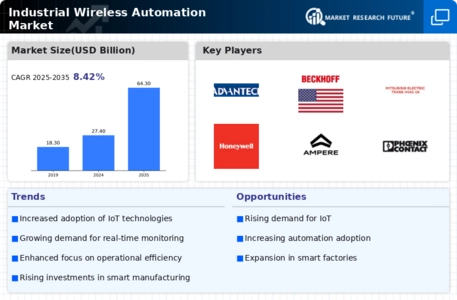Growing Demand for Automation Solutions
The Industrial Wireless Automation Market is experiencing a notable surge in demand for automation solutions across various sectors. Industries are increasingly recognizing the benefits of automation, such as improved efficiency, reduced operational costs, and enhanced productivity. According to recent data, the automation market is projected to grow at a compound annual growth rate of approximately 10% over the next five years. This growth is driven by the need for real-time data processing and decision-making capabilities, which wireless automation technologies facilitate. As companies strive to remain competitive, the adoption of wireless automation solutions becomes imperative, leading to a robust expansion of the Industrial Wireless Automation Market.
Increased Focus on Safety and Compliance
Safety and compliance are paramount in the Industrial Wireless Automation Market, driving the adoption of wireless automation solutions. Industries are increasingly mandated to adhere to stringent safety regulations, which necessitate the implementation of advanced monitoring and control systems. Wireless automation technologies facilitate real-time monitoring of equipment and processes, thereby enhancing safety measures and ensuring compliance with industry standards. The market is projected to grow as organizations prioritize safety and invest in technologies that mitigate risks. This focus on safety not only protects employees but also minimizes operational disruptions, further solidifying the role of wireless automation in the Industrial Wireless Automation Market.
Rising Need for Remote Monitoring and Control
The Industrial Wireless Automation Market is witnessing a rising need for remote monitoring and control solutions. As industries increasingly operate in decentralized environments, the ability to monitor and control processes from remote locations becomes essential. Wireless automation technologies facilitate this capability, allowing operators to manage systems without being physically present. This trend is particularly relevant in sectors such as oil and gas, where remote locations pose challenges for traditional monitoring methods. The demand for remote solutions is expected to drive growth in the Industrial Wireless Automation Market, as organizations seek to enhance operational flexibility and responsiveness.
Advancements in Wireless Communication Technologies
The Industrial Wireless Automation Market is significantly influenced by advancements in wireless communication technologies. Innovations such as 5G and LPWAN (Low Power Wide Area Network) are enhancing connectivity and enabling seamless communication between devices. These technologies provide the necessary bandwidth and low latency required for real-time data transmission, which is crucial for industrial applications. The integration of these advanced communication systems is expected to propel the market forward, as industries seek to leverage the benefits of high-speed connectivity. As a result, the Industrial Wireless Automation Market is likely to witness a transformation in operational capabilities, fostering greater efficiency and reliability.
Integration of Artificial Intelligence and Machine Learning
The integration of artificial intelligence (AI) and machine learning (ML) into the Industrial Wireless Automation Market is reshaping operational paradigms. These technologies enable predictive maintenance, optimizing performance and reducing downtime. By analyzing vast amounts of data generated by wireless automation systems, AI and ML can identify patterns and anomalies, allowing for proactive decision-making. This trend is expected to drive market growth as industries seek to enhance operational efficiency and reduce costs. The potential for AI and ML to revolutionize processes positions them as critical components in the evolution of the Industrial Wireless Automation Market.


















Leave a Comment